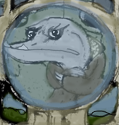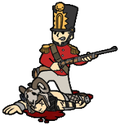|
WEEDLORDBONERHEGEL posted:The early 20th century, definitely, but this Passauer Kunst thing was full of do-it-yourselfers. I don't think anyone sold those little talismans, or Emergency Shirts, in an organized way. Well, the Edo period equivalent (before the advent of the tourist traps) was to stuff porn in your helmet or breastplate. 'For safety' you understand.
|
|
|
|

|
| # ? May 17, 2024 19:11 |
|
Retarded Pimp posted:You might be able to call the Petersburg Campaign a precursor to WWI, they spent months in trenches lobbing cannonballs and sniping each other, they even tried to blow the Confederate trenches from underneath, like in the Somme. The Union also experimented with a version of infiltration tactics. The American Civil War came at an interesting time for military technology. You start with smoothbore muskets and cavalry charges, and end with trenches and repeating rifles.
|
|
|
|
BurningStone posted:The Union also experimented with a version of infiltration tactics. The American Civil War came at an interesting time for military technology. You start with smoothbore muskets and cavalry charges, and end with trenches and repeating rifles. Also, let's see, wooden ships being trumped by ironclads, proto-submarines, land mines, and of course, airborne artillery spotters (although Wikipedia seems to think that the French did it first). Not including the boring stuff like telegraphs providing instant communications to the frontlines, photography helping relay home the cost of war, and of course, shuttling reinforcements around on interior railroad lines.
|
|
|
|
the JJ posted:Well, the Edo period equivalent (before the advent of the tourist traps) was to stuff porn in your helmet or breastplate. 'For safety' you understand. IT'S TO PROTECT ME, MOM. Next thing will be tomorrow, I'm drinking right now.
|
|
|
|
WEEDLORDBONERHEGEL posted:I really want to know if the Lakota picked ghost shirts up from German immigrants. It's 19th century, right? There's tons of German-Americans by that point. Crazy Horse's cousin Kicking Bear is the one who introduced the idea of ghost shirts protecting wearers from harm, and he probably got inspiration from the Mormons living in Nevada, where the Ghost Dance movement got started. The Ghost Dance movement is an interesting time in American history and I wish I knew enough to do it justice. Basically, it was a major Native American religious revival beginning around 1890, with support from the Mormons who believed Native Americans were privy to special Christian religious teachings. There was a lot of tension because of the U.S. government breaking treaty terms and trying to relocate the Sioux to arid farmland, which led to calls for violent resistance against the whites. The government sent in the military out of fear of an armed uprising, and they went around disarming chiefs known to support the movement. At Wounded Knee the disarmament got violent and the army killed over 100 civilians, which terrified the population and effectively ended the Ghost Dance movement. The Sioux leveraged popular outrage to force the government to acknowledge their treaty rights, so it amounted to a lot of running just to stay in the same place. 20 soldiers were awarded the Medal of Honor for their roles in the battle of Wounded Knee and subsequent massacre. There have been calls for the revocations of these medals, but a Medal of Honor hasn't been taken away in nearly a century and there doesn't seem to be the political will to do it now.
|
|
|
|
WEEDLORDBONERHEGEL posted:
Say my new name! Btw, this is related: http://de.wikipedia.org/wiki/Schluckbildchen Seems to be pretty old supersition. A few years ago I saw such papers in a church on the countryside.
|
|
|
|
Who's got good sources on the history of mercenaries in the 20th century and the contemporary world, esp. the US? I just contracted myself out to write an encyclopedia entry. Sorry JaucheCharly.
|
|
|
|
WEEDLORDBONERHEGEL posted:Who's got good sources on the history of mercenaries in the 20th century and the contemporary world, esp. the US? I just contracted myself out to write an encyclopedia entry. Are you looking for laws pertaining to, application of, or just accounts of how they are utilized? Edit: I have a former classmate who is doing some research in the legality of modern PMC's for her PHD, so I would just get some leads from her. Immanentized fucked around with this message at 16:44 on Apr 1, 2014 |
|
|
|
gradenko_2000 posted:How close to WWI-style trench warfare did the ACW come to? I always hear about how Cold Harbor was a precursor, but I don't really know any details. The most I'm familiar with is Pickett's Charge and how the artillery barrage wasn't all that effective at suppressing the Union defenders (although there were other factors as well such as coordination and ammo supply) Vicksburg was the first example of army-sized units deliberately entrenching in the ACW, though prior to that there were lots of examples of both sides making use of hasty fortifications and terrain features as proto-trenches (the "sunken roads" at Antietam and Fredericksburg are the most prominent examples). At Vicksburg Pemberton made fairly effective use of what we can probably call the first "modern" trenches, that is to say, trenches designed to facilitate lethal direct small arms fire while protecting the shooters. The point of this, in turn, being to slow down attackers long enough for field artillery to do its work. Petersburg of course is the archetypal example. Cold Harbor wasn't exactly a trenchy fight in itself, but it (along with Spotslyvania) demonstrated beyond any question that it was virtually impossible to defeat an entrenched modern army through direct full-scale attacks. Taking a look at Grant himself is probably the best way to get an idea of how the tactic developed. When Grant was advancing on Vicksburg, he knew well in advance that the CSA was entrenching heavily around the city. This was somewhat strange for the time, as armies in general preferred to remain mobile and avoid boxing themselves into things like cities (this is why sieges were relatively rare in the ACW compared to previous eras; the reason for this was the strategic importance of Vicksburg itself...the other two major sieges of the war, Atlanta and Petersburg, were also on major strategic objectives). Grant responded first by trying to overwhelm the defenders by attacking quickly, before the fortifications were well established, but wasn't successful. He then basically adopted tactics that were not unlike what we saw in WWI: "mirror" trenches, suppress the opponent with lots of rifle and artillery fire, grind it down. He probably should have learned there that frontal attacks against entrenched troops, even inferior forces, were a bad idea. So, onwards to the Overland Campaign, Grant is now in charge of everything and his strategy is just to hammer on Lee until he runs out of dudes. Lee has finally figured out that "spirit of the attack" or whatever is not a great idea and has adopted Longstreet's strategy of beating the opponent to key positions, entrenching, and then letting the opponent suffer massive casualties in frontal attacks. This is exactly what happened at Spotslyvania, North Anna, and Cold Harbor, with "better returns" happening in each case. It took the disaster at Cold Harbor for Grant to finally realize that his "CHARGE" strategy just wasn't working, so he went back to what he'd done at Vicksburg: dig in across from your opponent, pin them down, and grind it out. I won't detail the entirety of the Petersburg campaign; in short, it was pretty similar in a lot of ways to the Western Front in WWI with the exception that the trenches actually ended, and thus flanking maneuvers were sort of possible. bewbies fucked around with this message at 15:30 on Apr 1, 2014 |
|
|
|
WEEDLORDBONERHEGEL posted:I really want to know if the Lakota picked ghost shirts up from German immigrants. It's 19th century, right? There's tons of German-Americans by that point. To add to AATREK CURES KIDS summary, the Lakota during the Ghost Dance days would not have had a lot of close contact with German-American immigrants, as I understand it. They also were decidedly unfriendly towards most whites at the time, and for good reason. The number of whites on the reservation was very small until after WW2, when the Bureau of Indian Affairs invoked land ownership laws stating if a tribal member left their allotted land un-utilized for a certain period of time it would be remanded to the BIA. Of course, many Lakota left either to fight or work in factories, and after the war much of the allotted farmland on the reservation was taken from tribal members and later sold to white settlers. The early 1950s also saw the legalization of alcohol on the reservation and the height of the boarding school/reeducation programs where young Lakota where shipped off for ten months out of the year to have Catholic priests beat their native culture out of them (quite literally). Anyway, the Lakota were pretty culturally intact and isolated until the 1940s/50s when things really started to go downhill. They've only just started to recover in the last couple decades. Source: Albert White Hat, tribal elder. I grew up on a ranch on the Rosebud reservation. Edit: the Lakota didn't really get along with German-American or any European settlers. Prior to their military defeat and settlement on reservations, a white man on Lakota land was far more likely to be greeted by arrows or bullets rather than have a conversation about their cool magic trinkets. The Lakota were (still are, in many cases) immensely distrustful and hostile towards whites. Also worth noting that from 1883 to 1978, performing many Native American religious rituals was illegal under federal law. Pellisworth fucked around with this message at 16:05 on Apr 1, 2014 |
|
|
sullat posted:Also, let's see, wooden ships being trumped by ironclads, proto-submarines, land mines, and of course, airborne artillery spotters (although Wikipedia seems to think that the French did it first). They did, but it was more or less a one off experimental sort of thing. They pioneered the concept at least.
|
|
|
|
|
Fyi, there is a french baloon for artillery spotting on display at the Heeresgeschichtliches Museum in Vienna. From the Napoleonic Wars.
|
|
|
|
Retarded Pimp posted:You might be able to call the Petersburg Campaign a precursor to WWI, they spent months in trenches lobbing cannonballs and sniping each other, they even tried to blow the Confederate trenches from underneath, like in the Somme. To be fair to ~THE ANCIENTS~  , sniping during sieges (with bows) is as old as siege warfare, and mining to collapse enemy fortifications also pre-dates use of explosives. There was a period though when these dark arts were out of vogue, though, and again after WW1. , sniping during sieges (with bows) is as old as siege warfare, and mining to collapse enemy fortifications also pre-dates use of explosives. There was a period though when these dark arts were out of vogue, though, and again after WW1.I wonder if any NATO bases in Afghanistan are equipped with seismographs to reveal tunneling attempts...
|
|
|
|
Nenonen posted:I wonder if any NATO bases in Afghanistan are equipped with seismographs to reveal tunneling attempts... No reason to tunnel when you can just come right through the fence.
|
|
|
|
Probably going to spend a few week in Europe sometime in mid-late May or July. The idea is to hit some of the major WWII and WWI museums and battlefields in the area, but I'm also interested in seeing any worthwhile Napoleonic or Cold War sites as well. Any recommendation on places to visit, food, transportation?
|
|
|
|
WEEDLORDBONERHEGEL posted:Who's got good sources on the history of mercenaries in the 20th century and the contemporary world, esp. the US? I just contracted myself out to write an encyclopedia entry. Don't forget to cover outsourcing your logistics. http://www.amazon.com/Outlaws-Inc-Matt-Potter-ebook/dp/B005ERL4G8/ref=sr_1_1?s=books&ie=UTF8&qid=1396377785&sr=1-1&keywords=outlaws+inc Ex-Soviet Air Force personnel and planes will go anywhere carrying anything.
|
|
|
|
So I recently finished Guns of August and have been kicking around a small question in the back of my head ever since. At one point during the British and French retreat after the Battle of Frontiers it's pointed out that Kluck and Bulow are out of step in their advance, resulting in a twenty mile gap between their armies. How is that kind of thing usually calculated? Is it based on the actual distance between the closest small level units, or from the average location of the two closest divisions or just a rough estimation? This got me to thinking, what type of gap was generally thought to be acceptable at the time? Was the optimum actually to have both armies in direct contact, or was a gap of a mile or two not a big deal? Also does anyone have any recommendations for some works comparable to Guns of August covering the various major highlights of WW1?
|
|
|
|
cafel posted:This got me to thinking, what type of gap was generally thought to be acceptable at the time? Was the optimum actually to have both armies in direct contact, or was a gap of a mile or two not a big deal? I think Ernst Jünger describes his unit's position at one point as being on the flank of their army, and tieing in with their counterpart from the neighboring army by patrolling the gap in the line between them from both sides. Obviously 20 miles is far to great a distance for that. It becomes a problem because 20 miles is by far big enough to march an army through unseen and hit a unit in the flank. One or two miles was probably fine for a movement battle, since it can be covered relatively quickly.
|
|
|
|
handbanana125 posted:Are you looking for laws pertaining to, application of, or just accounts of how they are utilized?
|
|
|
|
bewbies posted:Words about Vicksburg and Grant Thanks a lot! Can someone recommend a good general history of American Civil War battles? I've only read Allen Guelzo's Gettysburg The Last Invasion and Stephen Sears' Chancellorsville, but I'd like to get something a bit more broad especially since I know so little about the Western theater and the late war. I was looking at John Keegan's The American Civil War: A Military History
|
|
|
|
How to Shoot Better Many of the recipes in this section were collected from Bohemian hunters in the 19th century. Could these also have been used by soldiers in the early modern period? Beliefs like these are often incredibly conservative, so I think it could be possible. On the other hand, it probably wouldn't have been too feasible for a soldier in the field to screw around with most of these recipes, which require elaborate processes, specific times, and ingredients that you might not be able to get everywhere. Casting bullets that will shoot precisely is common, but you can also do things to the weapon or add things to the powder. I would also like to stress that most of these recipes would make metal as hell inspirations for tattoos. Examples include: quote:To Hit The Target In The Black quote:To Hit What You Aim At quote:To Shoot Precisely And Always Hit quote:Help When Nothing Dies From Your Firearm quote:To Have A Precise Shot quote:To Make Bullets That Shoot Precisely quote:TO MAKE sympathetic BULLETS which are drawn to the nail in the target HEY GUNS fucked around with this message at 07:39 on Apr 2, 2014 |
|
|
|
WEEDLORDBONERHEGEL posted:I can understand the bats (they fly and can see in the dark), the birds (they fly), and the snakes (people used to think they spit their poison at people, for which you need good aim I guess), but otters? Is there some symbolic importance to otters I'm not getting? This is not the only recipe that involves otter body parts. I don't recall any special mystic attribute about Otters from Legends. At least none that I heard recently. Maybe it's more obvious, vipers are more or less the only really poisonous snakes around here. The bites also look particularly horrifying, as the poison causes necrosis.
|
|
|
|
Bacarruda posted:Probably going to spend a few week in Europe sometime in mid-late May or July. The idea is to hit some of the major WWII and WWI museums and battlefields in the area, but I'm also interested in seeing any worthwhile Napoleonic or Cold War sites as well. If you're visiting one war museum in Europe, make sure it's the Memorial in Caen, France. It covers WWI, WWII and the Cold War in a really great way, taking you through both the causes and consequences of each conflict. It's also pretty close to the Normandy beaches, and Verdun and the rest of the WWI western front isn't far off.
|
|
|
|
gradenko_2000 posted:Thanks a lot! I'm not a Keegan fan myself. McPherson's Battle Cry of Freedom is often called the best single volume book. Shelby Foote's trilogy is also good, but may be too much detail if you're just trying to grasp the major points.
|
|
|
|
BurningStone posted:I'm not a Keegan fan myself. McPherson's Battle Cry of Freedom is often called the best single volume book. Shelby Foote's trilogy is also good, but may be too much detail if you're just trying to grasp the major points. Talking about technological advancements and the ACW, ages ago I read the Bloody Crucible of Courage by Nosworthy, which provides a very analytical (almost scientific) approach to writing about the technological and tactical advancements present in the Civil War: I especially found it interesting for its analysis of the relative lack of casualties caused in hand-to-hand and bayonet combat and emphasises the psychological effect of close quarters combat (either the attack stalled during the approach or the defenders fled/surrendered relatively quickly after contact is made). It stands against most views of charges in the Civil War which had long, protracted hand-to-hand fights.
|
|
|
|
BurningStone posted:I'm not a Keegan fan myself.
|
|
|
|
I think that "Battle Cry of Freedom", in addition to being a pretty top quality history of the war itself, the first chapter is probably the single best novella-sized pre-ACW history of the US that I've ever read. It is just extraordinary.
|
|
|
|
Tekopo posted:I've read Battle Cry of Freedom as a pre-amble to reading Shelby Foote and it was decent enough, although it omits quite a considerable amount of detail, which is to be expected for such a relatively small book. It's easy to get into, so much so that I've given it to a friend of mine that doesn't read much ACW as a primer into the war. I made a post a while back about how even in the Napoleonic period bayonet combat just didn't happen outside of sieges or rare combat on broken ground. There's professional soldiers from the period agreeing that you might see actual hand to hand combat on the open battlefield once or twice in an entire career because one side would always lose their nerve before contact.
|
|
|
|
gradenko_2000 posted:Thanks a lot! https://www.youtube.com/watch?v=25HHVDOaGeE Here's every major battle, boom done.  In all seriousness, check out the Ken Burns documentary for sure.
|
|
|
|
gradenko_2000 posted:Can someone recommend a good general history of American Civil War battles? I've only read Allen Guelzo's Gettysburg The Last Invasion and Stephen Sears' Chancellorsville, but I'd like to get something a bit more broad especially since I know so little about the Western theater and the late war. I was looking at John Keegan's The American Civil War: A Military History If you're looking to focus on the West, "Nothing but Victory: The Army of the Tennessee" is readable.
|
|
|
|
Kaal posted:https://www.youtube.com/watch?v=25HHVDOaGeE That was hilarious.
|
|
|
|
BurningStone posted:I'm not a Keegan fan myself. McPherson's Battle Cry of Freedom is often called the best single volume book. Shelby Foote's trilogy is also good, but may be too much detail if you're just trying to grasp the major points. I was going to recommend Foote as well. I'm pretty sure they've broken down the trilogy in recent years to many smaller parts. For example, if you're just interested in the Vicksburg campaign, go ahead and grab that minivolume. I think they're about three hundred pages each.
|
|
|
|
gradenko_2000 posted:Thanks a lot! N'thing the recommendation for McPherson's Battle Cry of Freedom. The book reads incredibly easy owing to the narrative structure used, and everybody seems to agree that McPherson knows what he's talking about. It does spend the first third of the book talking about the run up to the war (which is a good thing I think), and spends very little time describing the actual battles themselves, so just be aware of that.
|
|
|
|
Are these Civil War books good about not advancing the Lost Cause poo poo?
|
|
|
|
Shimrra Jamaane posted:Are these Civil War books good about not advancing the Lost Cause poo poo? Depends. If you mean "does it offer an accurate and well informed view of the CSA", then yes. If you mean "does it go out of its way to vilify everything possible about the CSA regardless of accuracy or reason", then no.
|
|
|
|
Battle Cry of Freedom is pretty heavily pro-union from what I remember. Shelby Foote is pretty objective about his analysis even though he's from the south.
|
|
|
|
Yo, HEGEL- my lead was bunk. Can't get a hold of my friend. Sorry about that, I know RAND corp and even the US Army has published some solid papers on the matter of when PMC's would be preferable to full-fledged military interaction, but I can't get into JSTOR\WorldCAT anymore.
|
|
|
|
Tekopo posted:I've read Battle Cry of Freedom as a pre-amble to reading Shelby Foote and it was decent enough, although it omits quite a considerable amount of detail, which is to be expected for such a relatively small book. It's easy to get into, so much so that I've given it to a friend of mine that doesn't read much ACW as a primer into the war. I remember reading about that and the analysis is of wounds treated, in hospitals. A bayonet would probably dead you right there.
|
|
|
|
I recall WW2 vets telling over and over that the spade was prefered to the bayonet, because getting stabbed there's a good chance that it doesn't incapacitate. Always the spade to the neck/head.
|
|
|
|

|
| # ? May 17, 2024 19:11 |
|
handbanana125 posted:Yo, HEGEL- my lead was bunk. Can't get a hold of my friend. Try Melting it in a crucible with a bat  I found this site very useful for seeing the relationship between the battles of the American Civil War, especially back when I was a kid playing a game about a war I'd never heard of. It's a series of animations of the battles.
|
|
|
































 Yes, it's like a lava lamp.
Yes, it's like a lava lamp.


